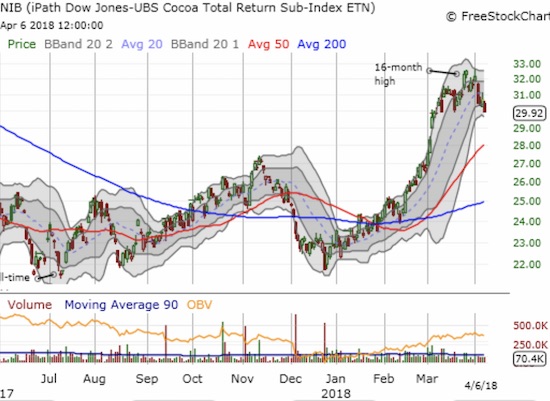On March 8th, I finally took profits and sold the rest of my holdings in iPath Bloomberg Cocoa SubTR ETN (NIB). In the past week, NIB came back down to my price and the ETN closed below my selling price to finish the week. I now think the price of cocoa, and thus NIB, has topped out for now.

Source: FreeStockCharts.com
Anatomy of a top
The topping action began with the deep pullback on March 19th that took NIB off the 16-month high at that time. Buyers stepped back in and were rewarded with a surge to new 16-month highs 4 and 5 days later. During that time, the Coffee and Cocoa Council (CCC) projected “Ivory Coast’s mid-crop cocoa output is expected to drop 23 percent this season due to insufficient rain and poorly kept fields” according to Reuters. The projected 400,000 tonnes is 120,000 tonnes short of 2017’s mid-crop production. I previously observed that the strong rally in cocoa was about cocoa forecasts coming up short of previous production numbers, so this news was not much of a surprise even if I had no expectation on specific numbers.
With cocoa up so much already, the classic trader concern is whether price action has finished pricing in the catalyzing news. The trading action following the news is often a good tell: if the price action reverses, traders do well to assume the catalyst has finished its work. Risk/reward dictates ending the trade with an easy re-entry if the price action resumes with a new high (or new low in a downtrend).
With the last surge to 16-month highs quickly giving way to downward price pressure, I think the answer is in: sell the news.
A top confirmed
Buyers had one last chance to prove that upside remained…and they failed. On April 2nd, NIB made a new intraday 16-month high but faded. Reuters reported that “speculators increased their net long position slightly to the highest since August 2016, showing less short-covering took place than some had expected, according to data that was released on Friday, when the markets were closed.” This speculative positioning is quite a turn-around from the record SHORT positioning that plagued cocoa in 2017. This high level of bullishness is a classic warning sign in commodity markets: it begs for a price reversal as increasingly supportive news is required to sustain the trend and supporting market sentiment. The release of the Ivory Coast mid-crop projections is that final news.
A flip in the narrative
With speculative position at lofty heights, news came from Ivory Coast that contradicted the forecast. According to Reuters on April 3rd: “Ivory Coast cocoa farmers said their trees were loaded with ripe cocoa pods and that sunny intervals last week enabled crops to dry, quelling fears that low rainfall earlier this year might have hit production.” NIB lost a whopping 5.2% on that day. This selling essentially confirmed a top in price.
On April 6th, Reuters blamed another cocoa sell-off on “improving crop prospects in Ivory Coast.” The narrative on cocoa has apparently changed. From here, I fully expect speculators to rapidly unwind longs and bring the price of cocoa down with them.
An ode to the cocoa farmer
While speculating in cocoa has been a modestly profitable exercise, there are of course millions of farmers for whom cocoa prices are the essence of life. Last week, PBS Newshour Weekend interviewed Dr. Kristy Leissle about her book “Cocoa” which “examines the politics that go into [cocoa’s] production with an analysis of power and inequality in the cocoa industry.” Leissle is currently based in Accra, Ghana and spent more than 10 years researching chocolate.
The somber interview included statistics like the huge gap between the value of cocoa beans and the final finished good of chocolate: $8B versus $100B a year. I reported earlier about the efforts of the governments of Ivory Coast and Ghana trying to figure out how to cooperate in securing more of the added value for their own people. These people, the farmers in particular, have to fight to make a living. According to Leissle:
“…they’re 90 95 percent or smallholder farmers which means they own very little small plots of land and they grow a tiny fraction…They live in really challenging conditions. The infrastructure that we enjoy here is not present in the areas where cocoa farmers live. And so things like paved roads and running water and electricity. Usually they don’t enjoy those things so it’s a very challenging life.”
Leissle estimated that the typical farmer makes $2 to $3 per day averaged out over time and shares that income with a family. Traders like me can clear that amount in a flash while at worst suffering finger cramps on the keyboard. The contrast is sobering for me. In coming months and years, I will be focusing more and more on the economic dynamics of the cocoa industry while weaving in the (episodic) trading opportunities. (For example, I will be looking for bounces at support from the 50 and/or 200-day moving averages).
Be careful out there!
Full disclosure: no positions
